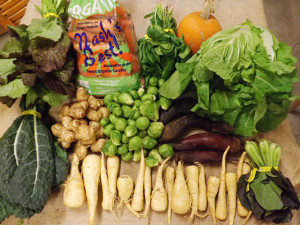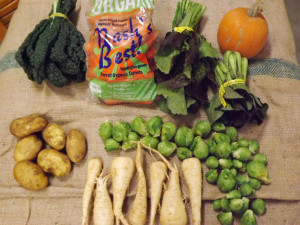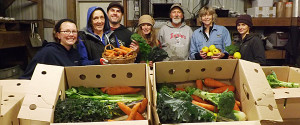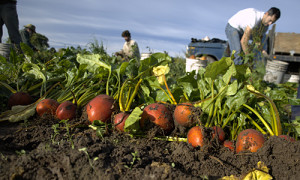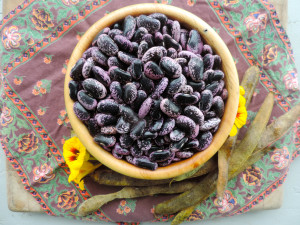Standard Box
Apples, 2 lb
Broccoli, 1.5 lb
Red Kale, 1 bu
Celery, Johnston Farms, 1 hd
Red Mizuna, 1 bu
Carrots, 3 lb
Leeks, 1 bu
Cauliflower, 1 hd
Red Chard, 1 bu
Red Beets, 1.5 lb
Small Box
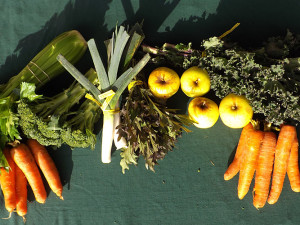
Apples, 2 lb
Broccoli, 1.5 lb
Red Kale, 1 bu
Celery, Johnston Farms, 1 hd
Red Mizuna, 1 bu
Carrots, 3 lb
Leeks, 1 bu
Brocolli—the Uber Veggie!
Broccoli is an excellent vegetable to include in your diet this winter if you are taking vitamin D supplements. Because of our decreased exposure to sunlight in the Pacific Northwest, especially this time of year, most people are advised to do so. But when you take vitamin D supplements, you should also consume vitamins A and K to properly metabolize the vitamin D. Broccoli is a rich source of both.
Broccoli also contains kaempferol, which is an antioxidant in the flavonoid family. Recent research has shown that kaempferol has the potential to mitigate the impact of allergic reactions within our bodies, because of its anti-inflammatory effects. Broccoli may play an important role in a hypo-allergenic diet. In addition, broccoli can offer great immune support as the weather turns cold, with a whopping load of vitamin C and zinc.
Broccoli Salad with Feta & Olives
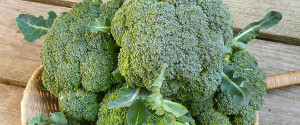
2 lbs broccoli
6 Tbsp. crumbled feta cheese
12 Kalamata olives, sliced or chopped
6 Tbsp. extra virgin olive oil
4 tsp. lemon juice
4 medium cloves garlic
Sea salt and pepper to taste
Optional
1 red onion sliced, add to steamer with stems or 2 minutes before florets
10 drops soy sauce
4 Tbsp. sunflower seeds
Fill the bottom of a steamer with 2 inches of water. While steam is building up in steamer, cut broccoli florets into quarters. Peel stems and cut into 1/4-inch pieces. Let florets and stems sit for 5 minutes to bring out their hidden health benefits.
Chop or press garlic and let sit for at least 5 minutes. Steam stems for 2 minutes before adding the florets. Transfer to a bowl. For more flavor, toss broccoli with the remaining ingredients and any of the optional ingredients while it is still hot.
This recipe was adapted from www.whfoods.com.
Mizuna
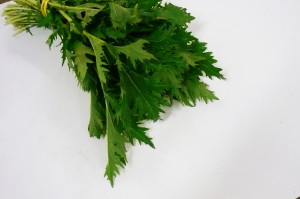
That feathery, red-tinged salad green in your box is called mizuna, a mild green related to mustard. It is high in immune-boosting vitamin C, folate, and iron,and also contains powerful glucosinolates—antioxidants linked to decreased cancer risk. Cultivated in Japan since ancient times, it is becoming a popular green in salad mixes. The following recipe uses it in a different, and unique way.
Chicken on a Bed of Mizuna
1 egg white, slightly beaten
1-1/2 tsp. soy sauce, divided
3 cloves garlic, minced
1 lb. boneless skinless chicken breast, finely chopped
2 tsp. vegetable oil, divided
1/3 cup carrots, finely chopped
1/3 cup yellow onion, finely chopped
1/3 cup sunchokes, finely chopped
1/2 tsp. chile paste
1 Tbsp. fresh lime juice
1 bunch mizuna, trimmed
1/4 cup green onions, finely chopped
In a bowl, mix the egg white with 1/2 tsp of soy sauce, minced garlic and chicken. Cover and refrigerate for 1 hour.
Heat 1 tsp. of the .oil in a wok or heavy skillet over high heat. Add the chilled chicken mixture and cook, stirring frequently for 4-6 minutes. Transfer chicken to a serving plate and set aside. Heat the other teaspoon of oil in the wok on high and add the carrots, onions and sunchokes; cook for 1 minute.
Add the remaining soy sauce, chile paste, lime juice and mizuna and cook, stirring often until mizuna is wilted. Return chicken to the wok and heat through. Garnish with green onions and serve.


